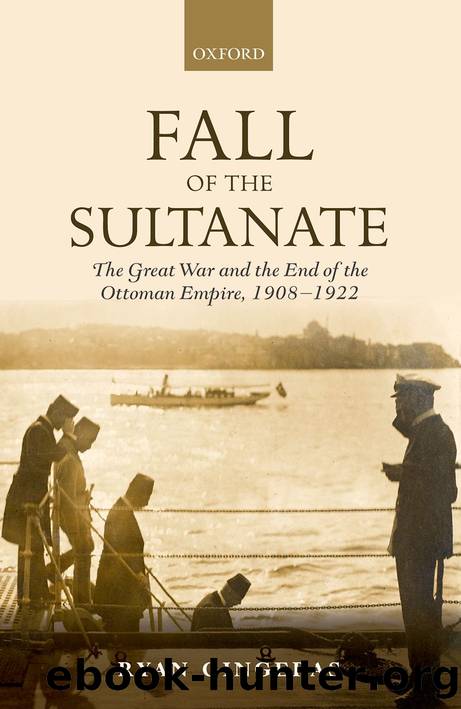Fall of the Sultanate by Ryan Gingeras

Author:Ryan Gingeras [Gingeras, Ryan]
Language: eng
Format: epub
ISBN: 9780199676071
Publisher: OUP Oxford
Published: 2016-02-22T00:00:00+00:00
The Great Disaster Commences, November 1914âApril 1915
Istanbulâs plan to liberate the Caucasus began soon after war with Russia was declared. Fighting along the OttomanâRussian frontier opened with the advance of relatively small parties of Ottoman irregulars and militiamen. Spearheading the offensive were advance elements of the Special Organization. Commanded by Bahaeddin Åakir, these units quickly seized the foothill town of Ardahan just across the border. As Åakirâs units moved forward along the Black Sea coast, mobile bands of militias and regular officers crossed over into Iranian territory with the intention of attacking Russian Azerbaijan from the south. Like the Special Organization force that occupied Ardahan, Ottoman troops that invaded Iran that winter were largely made up of locally recruited (usually Kurdish) fighters. With an eye toward raising rebellion among the regionâs tribes and townsfolk, Istanbul eventually dispatched preachers to spread word that a jihad had been declared against St. Petersburg. Fearing that their own citizens could be turned against the tsar, Russian military authorities had begun to deport Muslim men of military age from the Ottoman frontier well before the fighting began. Russiaâs expulsion of thousands of Muslim men from the border region failed to stem cross-border attacks by Kurdish irregulars. âPunish the Kurds mercilessly,â one Russian general ordered, ânot neglecting the most extreme measures, especially toward the leaders.â78
The Russian high command did not fail to exploit the service and sympathies of their own local recruits along the frontier. Thousands of Armenians and Muslims joined the ranks of the tsarâs armies. Mobilization on both sides of the imperial border thoroughly split ARF into two camps. A number of noted leaders concluded that a Russian victory over Istanbul was the only way to finally securing the safety and political authority the party had long stood for. In heading such calls, militant ARF leaders assembled a force of 4,000 fighters to operate alongside Russian troops by December 1914.79 Still other Armenian nationalists looked upon any outcome as a potential catastrophe-in-waiting for Armenians living in Ottoman lands. âThe Armenian people, whatever country they live in, should fulfill their citizenship duties,â one ARF official argued. âAn [armed] volunteer movement may have grave consequences.â80 Regardless of the divisions within the ARF, Ottoman military authorities took note of the rising number of armed Armenian bands appearing along the border. Small clashes between Ottoman soldiers and bands of Russian and native Armenians in the late fall and early winter of 1914 readily stimulated fears that wider rebellion was brewing in the east.
As Ottoman generals reeled from the near total destruction of the Third Army at SarıkamıÅ, reports of Armenian service in the Russian ranks and infiltration behind the lines were read with new eyes. Disturbances, such as an attack by Armenian villagers and military deserters on a local post office east of Lake Van, attracted the direct interest of Interior Minister Talat.81 Zeytun, a region notorious for its recalcitrant Armenians and Turkish tribes, again drew worried attention as acts of banditry and resistance to conscriptions proved rampant through the winter.
Download
This site does not store any files on its server. We only index and link to content provided by other sites. Please contact the content providers to delete copyright contents if any and email us, we'll remove relevant links or contents immediately.
| Bahrain | Egypt |
| Iran | Iraq |
| Israel & Palestine | Jordan |
| Kuwait | Lebanon |
| Oman | Qatar |
| Saudi Arabia | Syria |
| Turkey | United Arab Emirates |
| Yemen |
Empire of the Sikhs by Patwant Singh(23020)
The Wind in My Hair by Masih Alinejad(5056)
Rise and Kill First by Ronen Bergman(4739)
The Templars by Dan Jones(4656)
The Rape of Nanking by Iris Chang(4165)
12 Strong by Doug Stanton(3525)
Blood and Sand by Alex Von Tunzelmann(3164)
Babylon's Ark by Lawrence Anthony(2648)
The History of Jihad: From Muhammad to ISIS by Spencer Robert(2599)
No Room for Small Dreams by Shimon Peres(2343)
The Turkish Psychedelic Explosion by Daniel Spicer(2330)
Inside the Middle East by Avi Melamed(2325)
Gideon's Spies: The Secret History of the Mossad by Gordon Thomas(2319)
Arabs by Eugene Rogan(2279)
The First Muslim The Story of Muhammad by Lesley Hazleton(2245)
Come, Tell Me How You Live by Mallowan Agatha Christie(2228)
Bus on Jaffa Road by Mike Kelly(2123)
Kabul 1841-42: Battle Story by Edmund Yorke(2003)
1453 by Roger Crowley(1994)
